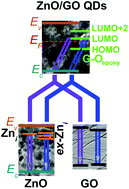Defect related emission versus intersystem crossing: blue emitting ZnO/graphene oxide quantum dots
Abstract
In ref. [Nat. Nanotechnol., 2012, 7, 465–471] interesting optoelectronic properties of ZnO/graphene oxide (GO) composite were presented. Essentially, in the luminescence spectrum indirect optical transitions were identified to be from the epoxy group of GO (GOepoxy) to the valance band (Ev) of ZnO. Viz. 406 nm, L1: (LUMO+2)GOepoxy → Ev and 436 nm, L2: (LUMO)GOepoxy → Ev. Furthermore, the emission peak at ∼550 nm was attributed to zinc interstitials (Znis) or oxygen vacancies (VOs) and shown to span from 350–650 nm (equivalent to a width of ∼0.8 eV). In this report we accentuate two vital though largely ignored concerns as itemized in the following. (i) By considering the growth mechanism of ZnO in the composite, there is a certain possibility that these two bands (L1 and L2) may originate from intrinsic defects of ZnO such as Znis and extended Znis (ex-Znis). Or L1 and L2 might be intrinsic to GO. (ii) The 550 nm emission involves VOs and consists of two components with a typical width of ∼0.3 eV. Here we present the results of a thorough investigation confirming the presence of Znis, ex-Znis and intrinsic emission from GO. We also note that during the synthesis the presence of dimethyl formamide significantly affected the emission from GO in addition to some chemical modifications. Apart from these, we have discussed other crucial factors which require deeper attention in the context of luminescence from complex systems such as those present.


 Please wait while we load your content...
Please wait while we load your content...